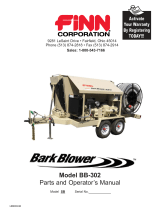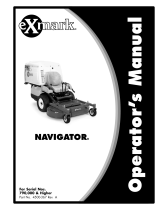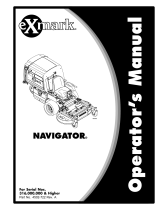Page is loading ...

LBBB1216-SM
ModelsBB-1216
PartsandOperator’sManual
ModelSMSerialNo._____________
9281LeSaintDrive•Fairfield,Ohio45014
Phone(513)874-2818•Fax(513)874-2914
PartsDept.: 1-800-229-8707
Sales: 1-800-543-7166


INDEX
SafetyFirst ................................................ 1
SafetySummarySection.................................... 2-5
Introduction ................................................ 6
TheFINNBarkBlowerandItsFunctions ......................... 6
HowtheBarkBlowerWorks ................................... 6
MountingtheBarkBlower................................... 7-8
SelectingaMulchingMaterial .................................. 9
Pre-StartEquipmentCheck ................................... 9
StartingProcdure .......................................... 10
CrewMembersandtheirDuties ............................... 10
TheMaterialFeedSystem ................................ 11-13
DescriptionofValveSections .............................. 11-12
BarkBlowerPowerStatusLights .............................. 14
MulchingwiththeBarkBlower ................................ 15
BarkBlowerAdjustments .................................... 16
TimerRangeProgramingInstructions .......................... 17
TroubleshootingChart .................................... 18-19
ClearingaBlockage ........................................ 20
QuickDumpFeature ........................................ 20
Maintenance ........................................... 21-23
FloorChainAdjustment...................................... 23
WinterStorage ............................................ 23
LubricationChart........................................ 24-25
Notes................................................. 26-28
PartsManualSection .................................... 29-64
LooseParts ............................................... 30
AgitatorAssembly .......................................... 31
FloorandFeedRollParts ................................. 32-33
AirLockParts .......................................... 34-35
PowerSystem .......................................... 36-37
Continued

AirIntakeandExhaustSystems ............................ 38-39
BlowerDriveAssembly ...................................... 40
BlowerSystem ............................................ 41
BlowerPipingAssembly .................................. 42-43
HydraulicSystem ....................................... 44-47
MachineFront ....................................... 44-45
MachineRear ....................................... 46-47
EngineWiring .......................................... 48-49
ControlsWiring ............................................ 50
RemoteControlParts ....................................... 51
ControlBoxLidComponents .............................. 52-53
ControlBoxElectricalComponents ......................... 54-55
ControlBoxWiring ...................................... 56-57
DustControlSystem ..................................... 58-59
TarpWiring ............................................... 60
TarpAssembly............................................. 61
200'HoseReelAssembly ................................. 62-63
DecalLocation ......................................... 64-65
ToolKit/HoseandAccessories/SpareParts .................... 66
Warranty ................................................. 67
WarrantyRegistrationCard................................... 68

1
SAFETYFIRST
Withanypieceofequipment,neworused,themost
importantpartofitsoperationisSAFETY!
FinnCorporationencouragesyouandyouremployeesto
familiarizeyourselveswithyournewequipmentandto
stresssafeoperation.
Thefirstsixpagesofthismanualareasummaryofallthe
mainsafetyaspectsassociatedwiththisunit.Besureto
readcompletelybeforeoperationofmachine.
Thissymbolisusedthroughouttheoperation
andmaintenancesectionsofthismanualto
callattentiontosafetyprocedures.
-PayAttention-
DANGER:ImmediatehazardswhichWILLresultinseverepersonalinjury
ordeath.
WARNING: HazardsorunsafepracticeswhichCOULDresultinsevereper-
sonalinjuryordeath.
CAUTION: HazardsorunsafepracticeswhichCOULDresultinminorper-
sonalinjuryorproductorpropertydamage.
IMPORTANT: Indicatesthatequipmentorpropertydamagecouldresultifinstruc-
tionsarenotfollowed.
NOTE: Giveshelpfulinformation.
FinnCorporation
CALIFORNIA
Proposition65Warning
Theengineexhaustandsomeofits
constituentsareknowntotheState
ofCaliforniatocausecancer,birth
defects,andotherreproductiveharm.
CALIFORNIA
Proposition65Warning
Batteryposts,terminalsandrelated
accessoriescontainleadandlead
compounds,chemicalsknowntothe
StateofCaliforniatocausecancer
andreproductiveharm.Washhands
afterhandling.

2
BARKBLOWERSAFETYSUMMARYSECTION
It is important that all operators of this machine are familiar with all the safety aspects mentioned
below before operating the machine. Always keep a copy of this manual with the machine. It is the
responsibilityoftheoperatorofthemachinetofullyunderstandthissafetysection.RememberthatYOUare
thekeytosafety.Goodsafetypracticesprotectnotonlyyoubutalsothepeopleworkingwithandaround
you.Keepinmindthatthissafetysheetiswrittenforthistypeofmachineonly.Practiceallotherusualand
customarysafeworkingprecautions;andaboveall,rememberthatsafetyisuptoyou.
I. PRE-STARTEQUIPMENTCHECK(equipment
checkistobemadewiththeengineoff):
1. Verifythatallguardsareinplace.
2. Bycarefullylookingintotheblowerhopperandtran-
sition, inspect for and remove any foreign objects.
Follow OSHA lockout/tagout procedure (29 CFR
1910.147)
3. Inspect all hydraulic hoses and tubes for cracks,
bulgesordamage.Ifhose isbad,replaceimmedi-
ately.
4. Inspect the material discharge hose and connec-
tions for cracks or damage. If damage is found,
replaceaffectedpartimmediately.
II. MACHINEOPERATION:
1. Always wear safety gog-
gles when operating or
feedingthemachine.Other
safety attire such as safe-
ty shoes, ear protection,
gloves, hard hats, dust
masks, etc., should be
wornasrequiredbywarn-
ing decals on machine,
operator’smanuals, orjob
requirements. Remove rings, watches, etc. Avoid
loosefittingclothingwhichmaygetcaughtin rotat-
ingmachinery.
2. Donotoverrideortamperwiththesafetyshutdown
switches on the folding door or discharge. If
switches fail, use OSHA lockout/tagout procedure
(29 CFR 1910.147) until switches are repaired or
replaced.
3. Do not operate the
machinewithoutallguards
inplace.
4. Never attempt to connect or disconnect the dis-
chargehosewhiletheengineisrunning.
5. Make sure that no one
is working in or on the
machine. Make sure the
discharge area is clear of
all persons, animals, etc.
Signal “All Clear” before
starting the engine. Keep
unauthorized personnel
awayfromthemachineand
dischargehoseatalltimes.
6. The driver of the towing vehicle is responsible for
the safety of the operator(s) and feeder(s) of the
machine. Make sure the driver is aware of and
avoidsallpossiblehazards,suchastreelimbs,low
powerlines,etc.
7. Do not allow anyone to ride on the trailer or any
otherpartoftheblowerforanyreason.
8. Never operate machine in
an enclosed area without
ventingtheexhaustofboth
theequipmentandthetow
vehicle. Deadly carbon
monoxidefumescanaccu-
mulate.
9. Never operate this or any other machinery when
fatigued, tired, under the influence of alcohol,
illegal drugs or medication. You must be in good
physicalconditionandmentallyalerttooperatethis
machine.
10.Nevermodify themachine.Neverremoveany part
ofthemachine(exceptforserviceandthenreinstall
beforeoperating).
11. During application, high pressure can be exerted
at the end of the hose. Always establish and
maintain good footing and hold the hose firmly.
Extrapersonnelmayberequired tohelp directand
hold the hose, especially when working on slopes.
Thepropertechniqueforhoseholdingpersonnelis
to firmly grasp the hose under both arms. Never
holdthehosesoitgoesbetweenthelegs.
12. The blower discharges material at pressures and
velocities that can cause severe bodily injury. Do
not aim discharge at people, animals, etc. Only
aim the discharge at the intended discharge area.
Unless properly protected, do not place hand into
thedischargestream.

3
13. Do not open any doors
or access panels while
machine is in operation.
Severe injury may result
fromrotatingparts.
14. Donotattempttopullany-
thing out of the blower
hopper when machine is
in operation. Shut down
the engine, using OSHA
lockout/tagout procedure
(29CFR1910.147)before
removing any foreign
objects.Signal“AllClear”
beforerestartingthemachine.
15. Whenleavingtheblowerunattendedforanyreason,
besureto:
A. Shutoffconveyordrive.
B. Shutoffvehicleengineandblowerengine.
C. Place transmission of the vehicle in “neutral”
or“park”.
D. Setparkingbrakefirmly.
E. Lockignitionandtakekeyswithyou.
F. Lockvehiclecab.
G. Ifonasteepgrade,blockthewheels.
Theseactionsarerecommendedtoavoidunau-
thorized use, runaway, vandalism, theft and
unexpected operation when the equipment is
restarted.
16. Do not read, eat or otherwise lose or lessen your
attentionin anymannerwhileoperating theblower.
Operatingisafulltimejob.
17. Be careful in getting on
and off the blower, espe-
cially in wet, icy, snowy or
muddy conditions. Clean
mud, snow or ice from
steps, fenders and foot-
wear.
18. All personnel operating and/or around the machine
mustbeawarethattheblowercanbecontrolledvia
remote control. For safety reasons and to prevent
accidental starting, always keep the power switch
on the remote receiver in the“OFF” position when
theremotecontrolisnotbeingused.
19. Be careful when operating
the tarp near power lines.
Raisingthetarpintopower
lines may cause severe
electrical shock. Always
have the tarp either fully
open or retracted when
transportingthemachine.
20. Turn slowly and travel on rough surfaces and side
slopes carefully, especially with a loaded blower
body.
III. MAINTENANCE:
1. Before servicing the
machine, turn off engine
andallow all movingparts
to stop. Disconnect the
battery cables to prevent
accidental starting of the
machine. Tag the engine
operatingareatoshowthat
the machine is being ser-
viced. Use lockout/tagout procedure (29 CFR
1910.147).
2. Take extreme care when
adjusting or replacing
knives.Knifeedgeisvery
sharp and can cause
severebodilyinjury.
3. Radiatormaintenance.Liquidcoolingsystemsbuild
uppressureastheenginegetshot.Beforeremov-
ing the radiator cap, stop the engine and let the
system cool. Remove the radiator cap only after
thecoolantiscool.
4. Battery maintenance. Lead-acid batteries contain
sulfuric acid which may damage eyes or skin on
contact.Alwayswearafaceshieldtoavoidacidin
the eyes. If acid contacts eyes, flush immediately
with clean water and get medical attention. Wear
rubber gloves and protective clothing to keep acid
offskin.Lead-acidbatteriesproduceflammableand
explosive gasses. Keep arcs, sparks, flames, and
lightedtobaccoaway.
5. Filling of fuel. Never fill the fuel tank with the
engine running, or while smoking or when near an
open flame. Never smoke while handling fuel or
workingonthefuelsystem.Thefumesinanempty
container are explosive. Never cut or weld on fuel
lines, tanks, or containers. Move at least 10 feet
(3 meters) away from fueling point before starting
engine.Wipeoffanyspilledfuelandletdrybefore
startingengine.

4
NOTE: Be careful not to allow fuel, lubricant,
hydraulic fluid, or cooling fluids to penetrate into
thegroundor bedischargedintothe water system.
Collectallusedfluidsanddisposeofthemproperly.
6. It is recommended that only authorized genuine
FINNreplacementpartsbeusedonthismachine.
7. Donotuseethercoldstartfluidifengineisequipped
withglowplug type preheater orother intake mani-
fold type preheater. It could cause an explosion or
fireandsevereinjuryordeath.
8. Dieselfuelorhydraulicfluid
under pressure can pen-
etratetheskinoreyesand
cause injury, blindness or
death. To check for such
leaks,useapieceofcard-
board or wood instead of
your hand. Pressure may
build up in the hydraulic
systemsousecautionwhenremovingthecap.
9. Somepartsandassembliesarequiteheavy.Before
attempting to unfasten anyheavypart orassembly,
arrangetosupportitbymeansofahoist,byblocking
or by use of an adequate arrangement to prevent
it from falling, tipping, swinging or moving in any
mannerwhichmaydamageitorinjuresomeone.
10. Ifrepairsrequireuseofatorchorelectricwelder,be
sure that all flammable and combustible materials
areremoved.Fueloroilreservoirsmustbeemptied,
steam cleaned and filled with clean water before
any cutting or welding on them is attempted. Do
NOTweldorcutonanytankcontainingoil,gasoline
or their fumes or other flammable material, or any
container whose contents or previous contents are
unknown.

5
CURRENTSETOFSAFETYDECALS
12179
Donotoperate
withoutguards
inplace.
22357
Turnengineoff,
disconnectbattery,
andallowallmoving
partstostopbefore
servicingequipment.
12251
Rotatingfanhazard.
K eephands clear.
Shutoffengine
beforeservicing.
012279
Topreventseriousburningorscalding:
•Pressurizedcoolingsystem.
•Allowsystemtocool.
•Removecapslowlywithgloveson.
HOTEXHAUST
012278
23519
Weareyeprotection
aroundoperating
equipment.

6
OPERATIONANDMAINTENANCE
MANUALFOR
FINNBARKBLOWER
INTRODUCTION:
TheFINNCorporationwouldliketothankyouforyourlatestFINNpurchase.Inoureffortstomaintaina
qualityandgrowingrelationshipwitheachandeverycustomer,wewouldliketoencourageyoutocontact
usforhelpwithservice,genuinereplacementparts,oranyotherinformationyoumyrequire.
THEFINNBARKBLOWERANDITSFUNCTION:
TheFINNBarkBlowerisanapparatusforconveyinganddischargingbulkmaterials,suchasbarkmulch,
atafastanduniformrateutilizingaminimumamountofmanpower.Theproducttobeusedisgenerally
compostedandprocessedandusedasasoilamendment,agroundcoverforerosionandweedcontrol,orfor
decorativepurposesonlandscaping(barkmulch).
Thismanualisintendedtoprovidestepbystepinstructionsontheoperation,care,andmaintenanceofthe
Bark Blower. In addition, it contains illustrations and a complete list of parts and components for easy
identification.
HOWTHEBARKBLOWERWORKS:
Thebulkmaterialisloadedintothehopperbyaloaderorbyafeedelevator.Locatedatthebottomofthe
hopperisadragconveyor,whichconveysthebulkmaterialtoanopeningcontainingafeedroll.Thefeed
rollanddragconveyorfeedthebulkmaterialintoarotaryairvalve(the“airlock”).Therotaryairvalve
isspecificallydesignedandbuilttohandletough,fibrousmaterial.Thefunctionoftherotaryairvalveis
totakethebulkmaterialintoopenpocketsexposedtotheoutsideairandtoconveyittoanareawherethe
pocketisclosedoff.Atthatpointahighpressureairstream,createdbytheblower,ischanneledthrough
thepocketcarryingthematerialoffandthroughthehosefordischarge.
IMPORTANT: For best results and to insure safe operation and long life of the
equipment,pleasereadandfollowallinstructionscarefully.

7
MOUNTINGTHEBARKBLOWER:
Theselectionofthevehicleonwhichabloweristobemountedhasimportantsafetyaspects.To
avoidoverloading:
A. Donotmountabloweronachassiswhich,whenfullyloadedwithmaterialtobespread,willexceed
eithertheGrossAxleWeightRating(GAWR)ortheGrossVehicleWeightRating(GVWR)forthe
chassis,seebelow.
B. Doinstallthebloweronlyonavehiclewithcab-to-axledimensionrecommendedfortheblower
bodylengthselected,seebelow.
Oncethepropercarrierhasbeenselected,theblowermustbesecurelymountedtoit.
CAUTION: Your FINN® Bark Blower should be mounted by a qualified
truckbodyinstaller.
IMPORTANT: Mounting the blower to the truck must allow for tire clearance
as well as frame twist. Place hard wood spacers along the
length of truck rails or use FINN® spring mounting kit (#011562)
orequivalent.
2. FollowmountinginstructionsgiveninFigure1(Page8).Ifmountingconditionsrequiredeviation
fromtheseinstructions,consultthefactory.
DIMENSIONS,CAPACITIES,ANDTRUCKREQUIREMENTS:
*CF - Backofcabtoendofframe
C - DistancefromfrontofBarkBlowertocenterofgravity
*CA/CT - Backofcabtocenterofrearaxleortrunnion
*FE - Frontaxleweight-Empty
FL - Frontaxleweight-Loaded
G - Distance from center of rear axle or trunnion to Bark Blower™
Centerofgravity
BW - BarkBlowerweight
*RE - Rearaxleweight-Empty
*RL - Rearaxleweight-Loaded
*WB - Truckwheelbase
* Thesedimensionsneededfromthetrucksupplieraswell
asFrontaxlecapacityandRearaxlecapacity.
** TruckGVWdependsonthetruckweight.CA/CTdimensionsare
approximateonly,anddependonthefrontandrearaxle
capacities,aswellasthefrontandrearemptyaxleweights.
*** WeightofBarkBlower,hosereelandmulch(800lbsperyard.)
Weightmayvarygreatlyduetothelargevarietyofmulchmaterials.
NOTE: This table was developed including the hose reel with 200’ of
hose. If no hose reel is to be installed the OAL, CA/CT and C
dimensionsmaybeshortenedby34”as wellasthe BW reduced
by750lbs.
Pounds
(kg)
Inches
(cm)
Inches
(cm)
Inches
(cm)
Pounds
(kg)
1216
33,000
(14,970)
192+
(487+)
153
(390)
274
(695)
23,000±
(10,430±)
TruckGVW
**
CA/CT
**
C
OAL
BW
***

8
GENERALMOUNTINGGUIDELINES:
(WBxFL)–(WBxFE)=G
BW
WBx(RE+HW-RL)=G
BW
G+CmustbeequaltoorlessthanCA
(WBxFE)+(GxBW)=FL
WB
(WBxRE)+BWx(WB–G)=RL
WB
TRUCKMOUNTINGCALCULATIONS:
3/16
Gap.
2
Bark Blower
Bark Blower
CF
OAL
CA/CT
RE
FE
RL
FL
WB
34
Ref.
C
BW
G
Center Of
Gravity
Bodyguides,ofheavyangle,shouldbeboltedor
welded to the truck frame near front end of the
BarkBlowerenginebase.Thisguiderestrictslat-
eral movment of hopper and thus relieves shear
stressonmountings.
Slotted angle on top with 1/2"
thickcoverstrap.
IMPORTANT:
Insurethattubesare
inserted to prevent
full compression of
springs when bolts
aretightened.
5/8" Grade 8 bolt &
nuts.-AllPlaces
Full length spacer thick
enough to cover rivet
heads; Drill clearnce
holes for rivet heads
whereneeded.
WARNING:
Do not weld or drill
truck frame in the
area.
Weld securely to Bark
Blower-bolt to truck
chassis
Figure1
MOUNTINGKIT
#11562

9
SELECTINGAMULCHINGMATERIAL:
SeveralfactorsmustbeconsideredwhenselectingmaterialtoconveythroughtheBarkBlower.Thevariety
ofthewoodused,howitisprocessed,itsmoisturecontent,andthepresenceofforeignobjectsalleffectthe
abilityoftheBarkBlowertoconveythemulchatauniformandacceptablerate.
Themulchmaterialmustbeprocessedand/orscreenedsothataminimumofmaterialisover2inches(5.1
cm)inanydirectionwithnomaterialexceeding4inches(10.2cm)inlength.TheBarkBlowerisnota
woodprocessor.Itonlyreducesmulchfiberswhentheyprotrudeabovetherotaryairvalve(airlock)vanes.
Asthevanesrotatepasttheknife,theprotrudingfibersareshearedoff.Ifthemulchcontainslongorlarge
fibers,andifthewoodfibersarehardertocut,thenthemachine’sthroughputisreduced.Forexample,if
twomulcheshavethesamemixofmaterialsizesthattheBarkBlowerrotormustcut,butoneissoftwood
likepine,andoneishardwoodsuchasoak,thepinewouldgothroughatahigherratebecauseitiseasier
tocut.
Two characteristics must be considered when selecting a material: the “greenness” of the wood and the
moistureofthemulchasawhole.Woodthatiswellseasonediseasiertocutthan“green”wood.Italso
processesbetter,makingalessstringymulch.Highmoistureinthemulchmaycauseittobridgeinthe
hopper.
Avoidusingmulchesthatcontainanyhardforeignobjectssuchasrocks,nails,steel,cans,glass,etc.These
objectscouldcausebodilyinjuryaswellasdamagetomachinecomponents,especiallythecuttingknives
intheairlock.
PRE-STARTEQUIPMENTCHECK:
CAUTION: Equipmentcheckismadewiththeengineoffandallrotating
partsstopped.
Safetychecktoinsureoperatorsafety:
1. Checkthatallthetruckmountingsaresecure.
2. Makesurethatallguardsareinplace.
3. ToolKit-seethatitcontainsallprescribeditems(seetoolkitlist,partsmanual).
4. Lubricateequipment-usehandgunonly(seelubechart,pages22-23).
5. Checkengineoil-refertoengineoperator’smanual.
6. Checkliquidcoolantlevelinradiator(protectedto-34ºF(-37ºC)whenshipped).
7. Checkfuellevel.Use#2-Ddieselfueloilunlessoperatingatambienttemperaturebelow40ºF(4ºC)
oratanaltitudeexceeding5000feet(1524meters).Intheseinstancesuse#1-Dfueloil.
8. Inspecttheengineaircleaner(refertotheengineoperator’smanual),theradiatorchaffscreen,and
thebloweraircleanerfordustanddirt.
9. Checkhopperandtransitionforforeignobjectsthatcouldinjureworkers,ordamageequipment.
10.Checkthefluidlevelinthehydraulictank.Checkthatservicevalveisopenonreservior.Proper
levelismidwaybetweentheupperandlowerindicatormarkonthesightgauge.(Seepage23for
oilspecification).
11.Install the discharge hose, using the short hot air hose section as the first connection after the
airlock.Thiswillhelpextendthelifeoftheotherhoses.Useclampsprovidedwiththemachine.
CAUTION: Donotuseradiatortypeclamps.Theseclampsmaynothold
undermachineoperatingpressure.

10
STARTINGPROCEDURE:
CAUTION: Seesafetysectionofthemanual(pages2-5)beforeoperating
themachine.
1. Turntheremotecontroltotheoffpositionontheremotecontrolpanel.
2. Turnthekeyuntilstarterengagesandtheenginefires.
NOTE: This engine has a safety system that will shut the engine off if
the engine oil pressure drops below 7 PSI (.48 bar) or if the
water temperature reaches 230º Fahrenheit (110º Centigrade).
This system has a 15 sec.override at startup to allow engine oil
pressure to build. If the key is left in the “Run”position for more
than 15 sec.without attempting to start the engine, the override
willexpireandthesafetyswitchwillcloseanddisabletheignition.
Theredlightabovetheignitionwilllightup,indicatingthekeymust
bereturnedtothe“Off”positionbeforerestarting.
3. Check that the “ON/FUSE” and “DOOR SWITCHES” lights are illuminated. If the green
“DOORSWITCHES”isnot,checkthatthefoldingdoorabovetheairlockistightlyclosedandthe
airlockdischargeistight.Ifbothlightsareoff,butthevoltmeterisreadingcorrectly,checkthe10
AMPcircuitbreakerinthecontrolbox(seeFigure3pg.15).Ifthevoltmeterisalsodead,then
checkthe30AMPcircuitbreakerinthecontrolbox.
4. Allowtheenginetowarmupforthreetofiveminutes.
5. Priortomulchapplication,movethethrottlepositiontofullyopen,andallowthegovernortocon-
troltheenginespeed.Governedenginespeedshouldbe2575to2625RPMunderload.
CREWMEMBERSANDTHEIRDUTIES:
1. TheOperatorcontrolstheplacementofthemulchbymovingandaimingthedischargehose.
2. TheLoader(s) feed material to the machine by using a bucket loader or belt conveyor dumping
materialdirectlyintothehopper.

11
THEMATERIALFEEDSYSTEM:
ThematerialfeedsystemontheBarkBlowerhasbeendesignedtogivefastanduniformmechanicalfeed-
ing.Theadjustablefeedingrateandtheautomaticreversecontrolsystemallowtheuseofvariedmaterials
whileobtainingmaximumproduction.Thesystemisanintegrationofthefollowingfoursubsystems,allof
whichcontributetoefficientmaterialflow:
SUBSYSTEM1:MATERIALHANDLINGGROUP
Thefourmajorcomponentsofthematerialhandlinggrouparetheblower,thedragconveyor,thefeedroll,
andtherotaryairvalve(airlock).
Theblowerisarotarylobe,positivedisplacementtypeunithavingtwodoublelobeimpellers.Itisdirect
drivenofftheengineflywheelbyaflexiblecoupling;thereforewhenevertheengineisrunning,airisbeing
pumped.Theblowerisequippedwithareliefvalvelimitingmaximumairpressureto14PSI(1bar),an
inletandoutletsilencerfornoiseattenuation,andaninletairfilter.
Thedragconveyorreceivesmaterialfromtheagitatedhopperandconveysittoanopeninglocatedatthe
rearofthehopper,wherethefeedrollislocated.Thefeedrollinsuresauniformfeedofbulkmaterialto
therotaryairvalve.Thedragconveyorispoweredbytwovariablespeedhydraulicmotorsmountedtoa
commongearbox.
Theairlockreceivesthematerialfromthedragconveyorandpressurizedairfromtheblower.Itsprimary
functionistoconveythematerialfromtheatmosphericairtoasealedchamberwheretheblowerairpicksit
upandblowsitoutofthehose.ToenabletheBarkBlowertoconveyfibrousmaterial,theairlockhousing
isequippedwithtwosharpcuttingknives,andthevanesontherotorareangledandhardened.Ifanylong
materialshouldprotrudeaboveavane,itwillbeshearedoffbeforethevaneenterstheclosetoleranceofthe
housing.Theairlockrotorisdirect-coupledtoabi-rotationalhydraulicmotorandgearbox.
SUBSYSTEM2:HYDRAULICSYSTEM
HydraulicpowerfortheBarkBlowerisgeneratedbyaflowandpressurecompensated,load-sensingpump
drivenoffoftheengineauxiliarydrive.Thismeansthepumpcanmeasurehowmuchloadisonthehydrau-
lic circuit and will only pump the oil needed to satisfy the demands of the circuit. The pump receives
10W-40hydraulicfluidfromthe36gallon(136liter)reservoirthroughaservicevalveandsuctionhose,
anddeliversittothevalvemanifold.Themanifoldhasfourseparatevalvesectionswithsolenoidsthat
controlallthefunctionsontheBarkBlower.Twopressuregaugesatthevalvemanifoldreadthevalveinlet
pressureandtheload-sensepressure.Oiltemperatureiscontrolledbythehydrauliccoolerlocatednearthe
hydraulicreservoironthedriver-sideofthemachine.
DESCRIPTIONOFVALVESECTIONS
Figure2showsthefourvalvesectionsandtheirlocations.Eachsolenoidoperatesinonlyonedirection,
socircuitsthatrequirebi-directionalflowhavetwosolenoids,suchasthegateandairlock.Thevalvescan
bestrokedmanuallybypressingintheblackbuttonsontheendofeachsolenoid.Allofthesectionssee
thesameinletpressureandtheloadsensingcapabilitiesofthepumpwillsupplyonlyasmuchflowasthe
highestdemandcircuitrequires.Ifanairlockvaneneedstocutatoughpieceofbark,theresistanceinthe
motorwillcauseapressurespikeintheairlockforwardcircuit.Thepumpwillsensethisandmarginally
increaseflowuntiltheloadisovercomeandthepressuredrops,atwhichtimethepumpwillde-strokeand
returntoitspreviousoutput.Eachcircuitinthehydraulicmanifoldblockispressurecompensatedsothat
eachvalvesectionwillonlyaccepttheoilflowneeded.Thismeansthatwhentheoverallpressureincreases
inthesystem,orinanyonecircuit,theflowthroughallthecircuitsremainsrelativelyconstant.

12
Floor
Agitator
(B Hot in Forward)
Airlock
(A Hot in Forward)
Feed Roll
Gate
(B Hot Up)
(A Hot Down)
Up
Rev. For.
For.
Rev.
Down
Figure2
A. GATE
Thebottomvalvesectionofthemanifoldcontrolsthedischargegate.Thevalvehasafixeddiameterorifice
tolimitthespeedofthegatecylinder.
B. ROTARYAIRVALVE(AIRLOCK)
Thesecondvalvesectionofthemanifoldrunstheairlock.Thespoolinthevalveisfactorysetsothatthe
airlockturnsatabout12RPM.Thepressurecompensatedneedlevalvestackedunderthesolenoidvalve
providesadjustmentoftheairlockspeedfromzerotoabout15RPM.Withtheneedlevalveturnedallthe
wayout,theairlockwillturnthefastest.Witheachfullturninoftheknob,theairlockwillslowdown
approximately3RPM.Thereisapressureswitchontheforwardcircuitthatissetfor2400PSI(165bar)
thattriggerstheauto-reversefunctionontheairlock.Normalrotationoftheairlockisclockwiseiflooking
fromthedriversideofthemachine.
C. DRAGCONVEYORFLOOR&FEEDROLL
Thethirdvalveupcontrolsthefloorandfeedrollspeed.Itisanelectricallydrivenproportionalvalvethat
iscontrolledbytheFloorSpeedtoggleswitchonthecontrolbox.Togglingtheswitchupordownvariesthe
inputvoltagetothesolenoidandmovesthespoolinthevalveaccordingly,allowingmoreorlessoilflowto
thefloorandfeedroll.Thefeedrollisplumbedinserieswiththefloor,meaningoilflowstothefeedroll
motorfirstandthendowntothefloormotors.Thissetupautomaticallycausesthefloortoslowdownifthe
feedrollbeginstojamup,preventingoverfeedingofthefeedroll.Thefloormotorsareplumbedinparallel
sothateachoneworksevenlyonthetandemgearbox.
E. AGITATOR
Thetopvalvesectioncontrolsthespeedandrotationoftheagitator.Thespoolinthissectionisfactoryset
sothattheagitatorrotatesatapproximately4RPM.Thissectionalsohasapressureswitchinstalledon
theforwardportthatissetfor2400PSI(165bar)thattriggerstheagitatorauto-reversefunction.Normal
rotationoftheagitatorisclockwiseiflookingfromtherearofthemachine.

13
SUBSYSTEM3:HYDRAULICCONTROLSYSTEM
ThehydrauliccontrolsystemisanelectricalsystemthatcontrolsallofthehydraulicfunctionsontheBark
Blower.This12-voltDCsystemrunsofftheengineelectricalsystem.Itisaseriesofrelays,locatedin
theelectricalcontrolboxontherearpassenger-sideofthemachine,whichcontrolthesolenoidvalvesin
thehydraulicsystem.ThesolenoidsareenergizedbywayofthewhiteDINconnectorsmountedoneach
solenoid.TheDINconnectorseachhaveasmallredlightinthemthatlightupifthecircuitisactive.This
isaneasywaytocheckifaparticularcircuithaselectricalpower.
Whenthe“Start”buttonispushedtheCR1andCR2relaysinFigure3(pg.17)areenergized.Thisinturn
energizestheforwardsolenoidontheairlockvalvesection,startingtheairlock.Ifthefloortoggleswitch
is“On”,thefloorandfeedrollsolenoidisalsoenergizedafterashortdelay.TimerrelayTR3delaysthe
startofthefloorsotheairlockalwayshasachancetoclearitself.TR3shouldtimeoutafter1.5seconds,
atwhichpointthefloorandfeedrollwillbegintomoveataspeedrelativetotheFloorSpeeddisplay.As
materialdropsintothetopoftheairlock,thepressurerequiredtocutthematerialismonitoredbythepres-
sure switch locatedonthe forwardport of theairlockvalvesection in themanifold(seeFigure 2). The
switchisnormallyopen.Whentheairlockmotorstallsduetotherotorencounteringanobjectitcannot
cut,highpressureiscreatedintheairlockcircuitandthepressureswitchcloses.Theamountoftimethe
pressureswitchisclosedismonitoredbythetimerrelayTR1inFigure3.Iftheswitchremainsclosedfor
morethan0.5seconds,TR1energizestimerrelayTR2.TR2automaticallyreversestherotorbyenergizing
thereversesolenoidandde-energizingtheforwardsolenoid.Italsode-energizesthefloorsolenoid,shutting
offthefloorandfeedroll.TheairlockwillremaininreverseuntilTR2timesout,whichisapproximately1
second.TimerrelayTR3willthenrestartthedragconveyorafterallowingtheairlocktoclearitself.
TheagitatorcircuitisalsowiredthroughtimerrelayTR3.Theagitatorwillstartonadelayjustasthefloor
doesandwillstopduringanairlockauto-reverse.TheagitatorcircuitontheBarkBloweralsohasanauto-
reversefeatureforwhentheagitatormaybecome“boggeddown”andbecomeunabletoturn.Thismost
oftenoccursatthebeginningofaloadwhenthehopperiscompletelyfullofwetorpackeddownmulch.
TimerrelayTR4willactivatewhenthepressureswitchontheforwardportoftheagitatorvalvesection
closes due to the high pressure created by the stalled agitator motor. TR4 automatically energizes the
reversesolenoidontheagitatorvalvecircuitandde-energizestheforwardsolenoid,causingtheagitatorto
rotateinreverse.TR4issetfor15seconds,afterwhichtimetheforwardsolenoidwillre-energizeandthe
agitatorwillreturntoitsnormalrotation.Thisprocessmayberepeatedseveraltimesuntiltheagitatorsuf-
ficientlybreaksupthepackedmulchmaterial.Theagitatorauto-reverseprocessdoesnotinterruptoraffect
anyotherfunctionsontheBarkBlower.
WhentheStopbuttonispushed,poweriscuttotherelays.Thisstopsthehydraulicmotorsonthefloor,
airlock,feedroll,andagitatorbyshuttingoffpowertothesolenoids.Thehydraulicscanalsobestopped
byshuttingofftheignitionkey.Pleasenotethatthehydraulicswillalsostopifthefoldingdooronthefeed
rollhousingorthedischargepanisopenedandcannotberestarteduntiltheyareclosedandtheStartbutton
ispushed.
SUBSYSTEM4:RADIOREMOTECONTROL
ThisBarkBlowerisequippedwithaRadioRemotetocontroltheMaterialFeedStartandStop,thefloor
speed,andtheenginethrottle.ItalsocontainsanEmergencyStopbuttonthatactivatestheMurphyshut-
downsystemontheengine.
IfusingtheRadioRemote,acertainstart-upsequencemustbefollowedtoactivatetheremote.Whenusing
theremote,startasfollows:
1. PlacetheRadioRemoteON/OFFswitch,locatedonthecontrolbox,tothe“OFF”position.
2. Placetheswitch,locatedontopoftheRadioTransmitter,tothe“OFF”position.

14
3. StarttheengineandallowtowarmupasspecifiedintheBarkBlowerinstructionmanual.
4. Placetheradioremoteswitchlocatedonthecontrolboxtothe“ON”position.
5. Placetheradiotransmitterswitchtothe“ON”position.
ToutilizetheMaterialFeedStart/StopfeatureoftheRadioRemote,theinitialstartmustoccurattheStart/
StopstationontheBarkBlower.Thehard-wired,Start/Stopontheunitistheprimaryandoverridingsetof
controls.WheneithertheStopbuttonispushedoralossofpowertotherelaysoccurs(i.e.thefoldingdoor
onthefeedrollhousingordischargepanisopened,oracircuitbreakertrips),theFeedStart/Stopfeatureon
theRadioRemoteisdeactivated.Thisfeaturewillremaininactiveuntiltheinitialstartisonceagainmade
atthemachinebypressingtheStartbutton.
TheMaterialIncrease/Decreasefunctionontheremotecanbeusedtochangethefloorconveyorspeedand
effectively adjust the ouput of mulch from the machine. Adjustments to the floor speed made from the
remotecontrolwillbeshownontheFloorSpeeddisplayonthecontrolbox.
TheEngineIncrease/Decreasefunctionontheremoteadjuststhethrottleactuatorontheengine.Foruseof
theengineRPMfunctionreferto“MulchingwiththeBarkBlower”onpage17.
PushingtheredbuttonlocatednexttotheantennaontheRadioTransmitteractivatestheMurphyshutdown
system.Thiswillshutofftheengine,automaticallyreturntheenginethrottlebacktoidle,andcutpowerto
alltherelayswhichwillshutdownallofthehydraulics.Toresetthesafetysystem:
1. FliptheRadioTransmitterON/OFFswitchto“OFF”.
2. Re-starttheengine.
3. FliptheradiotransmitterON/OFFswitchto“ON”.
BARKBLOWERPOWERSTATUSLIGHTS:(SEEFIGURE3)
TheBarkBlowerisequippedwithfivePowerStatusLightsontheelectricalcontrolbox.Eachglowing
lightindicatesthatafunctionisreadyforoperation.Alistofthelightsastheyappearfromtoptobottom
andthemeaningofeachfollows:
*NOTE: The amber light will deactivate whenever the red Auto-Reverse
lightcomeson.
LightColor
Blue
Function
ON/FUSE
Indicator
Should be glowing when engine key is on. Shows power
from the ignition switch through the 10 amp circuit breaker
intotheelectricalcontrolbox.(Willshutoffwhenfeeding)
Green DOORSWITCHES Shouldbeglowingwhenenginekeyisonifthefoldingdoor
anddischargepanareclosedandtheinterlockswitchesare
makingpropercontact.(Willshutoffwhenfeeding)
Amber FEEDING ShouldbeglowingwhenevertheStartbuttonispushedacti-
vatingtheBarkBlowerhydraulicsystem*.
Clear REMOTEFEED
STANDBY
Should be glowing anytime feeding is stopped by pressing
the Material Stop button on the Radio Transmitter. Warns
othercrewmembersthattheRadioTransmitterisactiveand
feedingcanbeginremotely.
Red AUTO-REVRSE Should be glowing whenever the unit auto-reverses while
feeding*.

15
Figure3
MULCHINGWITHTHEBARKBLOWER:
1. Checkallareaslistedunder“Pre-StartEquipmentCheck”(pages10-11).
2. Starttheenginefollowingallthestepslistedunder“StartingProcedure”(page11).
3. Setthefloorspeedcontrolto3.
4. Openthegatetothemaximumopening.
5. Refertotheremotecontrolstart-upprocedureonpage15.
6. PutthedragconveyorFloorswitchtotheONposition.
7. Toactivatethedustcontrolsystem,fliptheDustControlswitchtoON.Thedustcontrolsystem
willonlyoperatewhentheFloorswitchisintheONposition.Theneedlevalveabovetheairlock
dischargepancanbeadjustedforvaryingflow.
8. Press the Start button on the main control panel to activate the material start/stop feature on the
remoteandatthesametimepresstheMaterialStopontheremote.Remotefunctionsarenowactive
andtheclearRemoteFeedStandbylightshouldbeon.
9. Increasethethrottletofull.
10.Withafirmgripontheendofthehose,presstheMaterialStartbuttonontheremote.
11.Floorspeedcanbeadjustedfrom3forsmoothflow.Watchforauto-reversingoftheairlockaswell
asshockwavesthroughthehose.Listenforthereliefontheblower.Partialpluggingintheairlock
dischargeorhosemaycauseittoopen,causingahighpitchedwhine,indicatingover-feedingofthe
airlock.
12.UsetheEngineRPMbuttonontheremotetodecreaseandincreaseairandmaterialflow.Alower
engineRPMmayrequirealowerfloorspeedtoavoidauto-reversingorplugging.
13.Attheendoftheload,hitMaterialStopandshutdowntheengine.
MainControlPanel
RadioRemote
D-COIL/FUEL (10A)
NORMAL TIMER SETTINGS:
#1-TR1 (A.L. PRESS SWITCH) 0.5 SEC.
#2-TR2 (AIR LOCK REVERSE) 1.0 SEC.
#3-TR3 (FLOOR DELAY) 1.5 SEC.
#4-TR4 (AG. PRESS SWITCH) 15 SEC.
F-THROTTLE (5A)
E-WATER INJ (10A)
21
19
5
3
2
1
A-MAT'L FEED (10A)
C-FLASHING LIGHT (10A)
18-ACCESSORY FUSE HOLDER
B-REMOTE (5A)
4-TR4
5-CR1
6-CR2
19-FLOOR CONTROL CARD
1-TR1
2-TR2
3-TR3
MATERIAL
MATERIAL
ENGINE RPM
FINN
CORPORATION
DECREASE
STOP
DECREASE
EMERGENCY
STOP
INCREASE
START
INCREASE
OFF/ON
TRANSMITTER
Emergency
Stop
Transmitter
OFF/ON
(See Page 21 for timer
instructions.)
E
F
D
B
C
4
6
13
14
15
16
17
18
22
11-30A BREAKER
10-FLASHER
9-EMER STOP
8-TCR2
7-TCR1
12-QUICK DUMP
21-REMOTE CONTROL BOX
22-TERMINAL STRIP
A
7
12
11
10
8
914-ELEC STOP
15-WATER INJ
13-MATL STOP
17-ENG SAFETY
16-MATL HOPP
20
20-FLOOR DISPLAY CARD
autoMreverse
feeding
auto@reverse
test@switch
remote@feed
standby
door@switches
onOfuse
down
gate
up
on
off
floor
idle
throttle
full
remote
off
on
decrease
increase
floor@speed
dust
off
on
control speed
floor
QV
start
P
hours
quartz
PPPPP QP
Q
volts
QR
QP
QT
stop
QP RP
SP
tach

16
BARKBLOWERADJUSTMENTS:
YourBarkBlowerhasbeendesignedtobeassimpleaspossibletooperate.Thefeedrollandairlockare
designedtocreateasmooth,consistentflowofmaterialfromthehoppertothedischarge.Theagitatorhas
beendesignedtoeliminatepossiblematerialbridginginthehopperandtohelpimprovemulchconsistency
asitentersthefeedrollchamber.However,materialconditionscanchangefromoneloadtothenextor
fromonedaytothenext.Theonlyadjustmenttheoperatorshouldhavetomakeistothedragconveyor
speed.AdjustingthefloorspeedwillallowtheBarkBlowertoefficientlyconveymanydifferenttypesof
mulch.
Knowingwhenandhowmuchtoadjusttheflooristhekeytomaximizingthemachine’sperformance.The
floorconveyorspeediscontrolledbytheFloorSpeedtoggleswitchontheelectricalcontrolboxandbythe
MaterialFeedtoggleswitchontheremote.Thefloorspeedcanbeadjustedfrom0to10ontheFloorSpeed
displaywith0beingtheslowest(0RPM)and10beingthefastest(approx.8RPM).Formostmaterials,a
settingof3isagoodstartingpoint.Thefloorspeedcanbeincreased(incrementsarerecommended)until
certainwarningsignsappear.Theyincludethefollowing:
A. CONSISTENTHOSESHOCK
TheBarkBlowerusesalargeamountofairtoblowthemulchmaterialthroughthedischargehose,which
can become difficult for an operator to handle. If rough shock waves become consistently tough on the
operatorattheendofthehose,thefloorcanbeturneddowntosmoothouttheflowofmaterialintothe
airlock.CuttingbackontheengineRPMcanalsosmoothoutthehosesincetherewillbelessairbeing
pumpedthroughthehose.Hoseshockisusuallyduetopartialpluggingaroundthedischarge.Whenthe
materialgetsdislodged,thelargerclumpsareshotthroughthehoseandcanmakeitjumpsignificantly.
Anotheradjustmentthatcouldhelpwithhoseshockistheairlockspeeditself.RefertotheAirlocksection
ofthe"MaterialFeedSystem"onpg.12forinstructionsonhowtoadjusttheairlockspeed.Certainmateri-
alsmayrunmoresmoothlywithafasterorslowerairlock.Generally,theairlockshouldnotberunany
slowerthan8RPMandcanbeadjustedupto15RPM.
B. EXCESSIVEAUTO-REVERSING
Iftheairlockstartstoauto-reverseregularly,i.e.morethanthreetimesaminute,thentheairlockisbeing
overfedandthefloorshouldbeturneddown.Excessiveauto-reversingleadstolessproductionthanifthe
floorwasjustturneddowntoalowerRPM.Thisconditionwilloccurmoreoftenwithstringymulchorless
processedmaterialthatcontainslargerchunksofwoodthattheairlockmayhavetocut.
C. REGULARLYTRIPPINGTHEBLOWERRELIEF
Thebloweronyourmachinehasareliefvalveintheairlinetoprotectthebloweragainstalargebackpres-
surethatcouldbuildifthelinebecomesplugged.Thereliefvalve,setfor14PSI,islocateddirectlybehind
theblowerintheengineareaonthefrontofthemachine.Ablockage,temporaryorotherwise,cantripthe
relief,whichcausesaloudwhiningnoisetobeheardfromtheenginearea.Occasionalblowingthroughthe
reliefisexpected,aslongasthemachinecanclearitself.However,ifthereliefgoesoffrepeatedlyina10
secondspan,thenthedischargeareaorhoseisindangerofbecomingcompletelyblocked.Thefloorspeed
shouldbeimmediatelyreduceduntilthereliefvalveisnotheardconsistentlygoingoff.Partialplugging
mostoftenoccurswithlessprocessedmaterialorifthemulchiswetanddense.
Thegatemayalsobeusedtohelpsmoothouttheflowofmaterialandimproveproduction.Loweringthe
gate effectively shrinks the opening in the back of the machine that the material must pass through as it
entersthefeedrollhousingandthentheairlock.Sometimesreducingthesizeofthatopeningmayproduce
amoreconsistentflowofmaterial,especiallywithfinermaterialsuchascompost.
/













